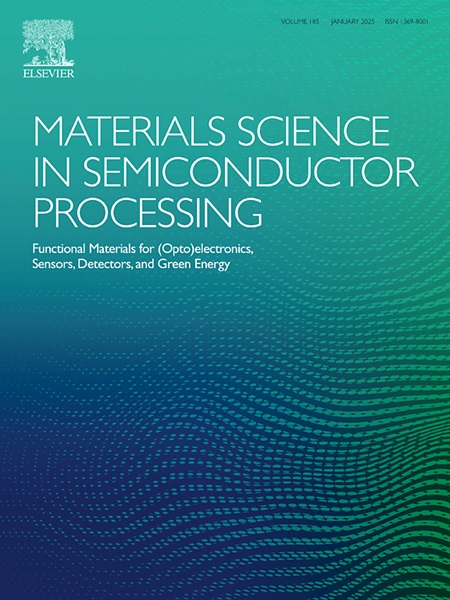Harnessing MnCdS/AgIn5S8 heterojunction with promoted interfacial charge transfer for ultra-high efficiency photocatalytic degradation of levofloxacin
IF 4.6
3区 工程技术
Q2 ENGINEERING, ELECTRICAL & ELECTRONIC
引用次数: 0
Abstract
Pharmaceutical pollutants in aquatic environments represent major ecological and health problems owing to their persistence and bioactivity, emphasizing the need of effective degrading solutions. Herein we report a S-scheme MnCdS/AgIn5S8 heterojunction synthesized through hydrothermal cum physical mixing that utilizes visible light irradiation to efficiently degrade levofloxacin (LEV) antibiotic. The 20 % MnCdS/AgIn5S8 heterojunction demonstrated exceptional photocatalytic efficiency with 94.30 % degradation at neutral pH under 80 min light irradiation. The photocatalytic performance of the heterojunction was optimised by investigating several operational factors such as pH, catalyst dosage and starting levofloxacin concentrations. Optimal degradation occurred at neutral pH, with higher dose (30 mg) of improving the degradation rate owing to the availability of active sites. The improved performance is ascribed to the construction of heterojunction, which effectively separates photogenerated electrons and holes in space, reducing recombination. Scavenging studies using potassium iodide (KI), benzoquinone (BQ) and isopropyl alcohol (IPA) and electron spin resonance (ESR) spectra were used to determine the key active species participating in the degradation process. The heterojunction offers an eco-friendly approach to the breakdown of organic contaminants owing to its exceptional stability and reusability across five cycles. This work advances the technique of photocatalytic pollutant degradation by offering a viable method for the solar-driven degradation of pharmaceutical pollutants.

利用MnCdS/AgIn5S8异质结促进界面电荷转移进行超高效光催化降解左氧氟沙星
水生环境中的药物污染物由于其持久性和生物活性,构成了重大的生态和健康问题,强调需要有效的降解解决方案。本文报道了一种S-scheme MnCdS/AgIn5S8异质结,通过水热和物理混合合成,利用可见光照射有效降解左氧氟沙星(LEV)抗生素。20% MnCdS/AgIn5S8异质结表现出优异的光催化效率,在中性pH下80 min光照下降解率为94.30%。通过考察pH、催化剂用量和左氧氟沙星起始浓度等操作因素,优化了异质结的光催化性能。最佳降解发生在中性pH下,由于活性位点的可用性,较高剂量(30 mg)可提高降解率。性能的提高是由于异质结的构建,它有效地将光生电子和空穴在空间上分离,减少了复合。利用碘化钾(KI)、苯醌(BQ)和异丙醇(IPA)的清除研究和电子自旋共振(ESR)光谱来确定参与降解过程的关键活性物质。异质结提供了一种生态友好的方法来分解有机污染物,因为它具有卓越的稳定性和跨五个循环的可重用性。这项工作通过为太阳能驱动的药物污染物降解提供一种可行的方法,推动了光催化污染物降解技术的发展。
本文章由计算机程序翻译,如有差异,请以英文原文为准。
求助全文
约1分钟内获得全文
求助全文
来源期刊

Materials Science in Semiconductor Processing
工程技术-材料科学:综合
CiteScore
8.00
自引率
4.90%
发文量
780
审稿时长
42 days
期刊介绍:
Materials Science in Semiconductor Processing provides a unique forum for the discussion of novel processing, applications and theoretical studies of functional materials and devices for (opto)electronics, sensors, detectors, biotechnology and green energy.
Each issue will aim to provide a snapshot of current insights, new achievements, breakthroughs and future trends in such diverse fields as microelectronics, energy conversion and storage, communications, biotechnology, (photo)catalysis, nano- and thin-film technology, hybrid and composite materials, chemical processing, vapor-phase deposition, device fabrication, and modelling, which are the backbone of advanced semiconductor processing and applications.
Coverage will include: advanced lithography for submicron devices; etching and related topics; ion implantation; damage evolution and related issues; plasma and thermal CVD; rapid thermal processing; advanced metallization and interconnect schemes; thin dielectric layers, oxidation; sol-gel processing; chemical bath and (electro)chemical deposition; compound semiconductor processing; new non-oxide materials and their applications; (macro)molecular and hybrid materials; molecular dynamics, ab-initio methods, Monte Carlo, etc.; new materials and processes for discrete and integrated circuits; magnetic materials and spintronics; heterostructures and quantum devices; engineering of the electrical and optical properties of semiconductors; crystal growth mechanisms; reliability, defect density, intrinsic impurities and defects.
 求助内容:
求助内容: 应助结果提醒方式:
应助结果提醒方式:


